|

Weights and Measures: Raccoons range from 50 to 100 cm (20 to 40 inches) in length (including the tail) and weigh between 4.5 and 16 kg (10 and 35 pounds). The raccoon's tail ranges from 20 to 40 cm (8 to 16 inches) in length. Male raccoons are generally larger than females.

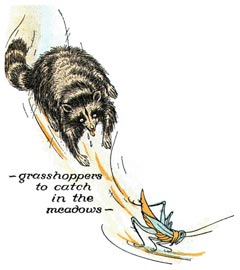 What's for Dinner? All raccoons are nocturnal and omnivorous, eating berries, insects, eggs and small animals. What's for Dinner? All raccoons are nocturnal and omnivorous, eating berries, insects, eggs and small animals.
Clean Your Food! Raccoons sometimes wash, or douse, their food in water before eating it. It is unknown why raccoons perform dousing, but cleaning food is unlikely to be the reason. Studies have found that raccoons engage in dousing motions when water is unavailable; researchers note that captive raccoons are more likely than wild raccoons to douse food.
But Why? It has been suggested that captive raccoons are mimicking fishing and shellfish-foraging behaviors. It may also be that the raccoon is searching for unwanted material, as water is thought to heighten their sense of touch.
Urban Animals: As city dwellers in the United States and Canada increasingly move into primary or second homes in former rural areas, raccoons are often considered pests because they forage in trash receptacles. The raccoon has also adapted well to city life, and in cities such as Toronto the raccoon is, after the gray squirrel the most common urban pest. Introduced into Germany in the 19th century, raccoons seeking food in wine cellars and storage areas have become a threat to the country's wine industry.
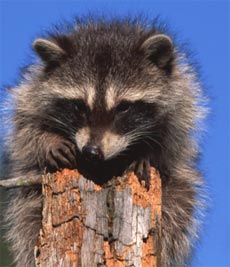 Raccoons Gone Wild: Beginning in April 1934 raccoons, which were being commercially farmed in Germany for their then-fashionable fur, were experimentally released into the wild in the Kellerwald range. Population growth greatly accelerated in 1945 when disruption of the infrastructure led to numerous raccoons escaping from farms across Germany. Raccoons Gone Wild: Beginning in April 1934 raccoons, which were being commercially farmed in Germany for their then-fashionable fur, were experimentally released into the wild in the Kellerwald range. Population growth greatly accelerated in 1945 when disruption of the infrastructure led to numerous raccoons escaping from farms across Germany.
Because they seemed to have minimal impact on forest ecology, raccoons were a protected species. Lately, however, the population density in some regions may have reached 100 raccoons per square kilometer and hunters have been offered rewards to cull the animals.
Raccoons as Pets? In most states of the United States it is illegal to keep raccoons as pets. Other states allow the practice, but require exotic pet permits. Young orphan raccoons and raccoons acquired from reputable breeders may make suitable pets; however, raccoons are not domesticated animals. Training raccoons is an intensive and ongoing process, and captive raccoons may retain destructive or aggressive natural behaviors, such as biting. Some douse their food in or defecate into the water dishes of other pets. Although nocturnal, captive raccoons can be trained to sleep at night and to be active during the day.
Captive raccoons can develop obesity and other disorders due to unnatural diet and lack of exercise; furthermore, many veterinarians will not treat raccoons. Raccoons raised in captivity and released do not adapt well to life outside.
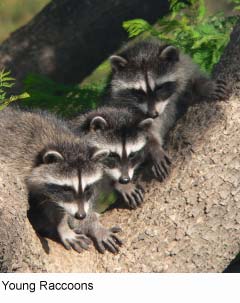 The Common Raccoon: The Common raccoon (Procyon lotor), also known as the Northern raccoon, racoon, or coon, is a widespread, medium-sized, omnivorous mammal of North America. The Common Raccoon: The Common raccoon (Procyon lotor), also known as the Northern raccoon, racoon, or coon, is a widespread, medium-sized, omnivorous mammal of North America.
They have black facial colorings around the eyes, and have a bushy tail with light and dark alternating rings. The coat is a mixture of gray, brown, and black fur. On rare occasions, raccoons may be albino.
The characteristic eye colorings make the animal look like it is wearing a "bandit's mask," which has only enhanced the animal's reputation for mischief, vandalism, and thievery.

Single Mothers: The Common raccoon usually mates in January or February and a litter of four or five young are born in April or May (varies by climate). Raccoons usually live in hollow trees, ground burrows, or caves.
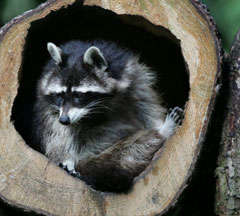 They like to travel along streams or rivers in search of food. However there are raccoons that live in the forest not near any stream. Males have no part in raising the young. They like to travel along streams or rivers in search of food. However there are raccoons that live in the forest not near any stream. Males have no part in raising the young.
Long Live the Raccoon! By late summer, the litter will be weaned and will begin to fend for themselves. In severe winter climates, raccoons may become dormant but do not hibernate. Raccoons have been known to live up to 12 years in the wild, but most live for only a few years.

3 Times the Charm: There are three species of raccoon. The most widespread is the Common raccoon, which has a natural range of North America, and has been introduced to Continental Europe.
The two rarer species are the Tres Marias raccoon (P. insularis), native to the Caribbean, and the Crab-eating raccoon (P. cancrivorus) of the tropics. The word "raccoon" is derived from the Algonquian word aroughcoune, "he who scratches with his hands." The genus name, Procyon, comes from the Greek for "pre-dog"; this term is also used for the star Procyon.
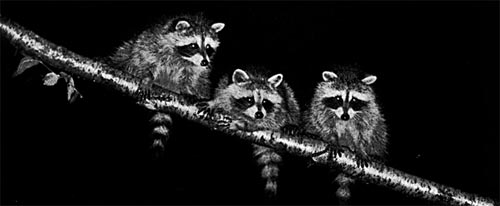
All text is available under the terms
of the GNU Free Documentation License
|